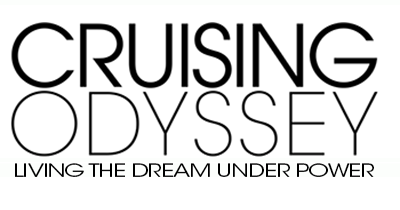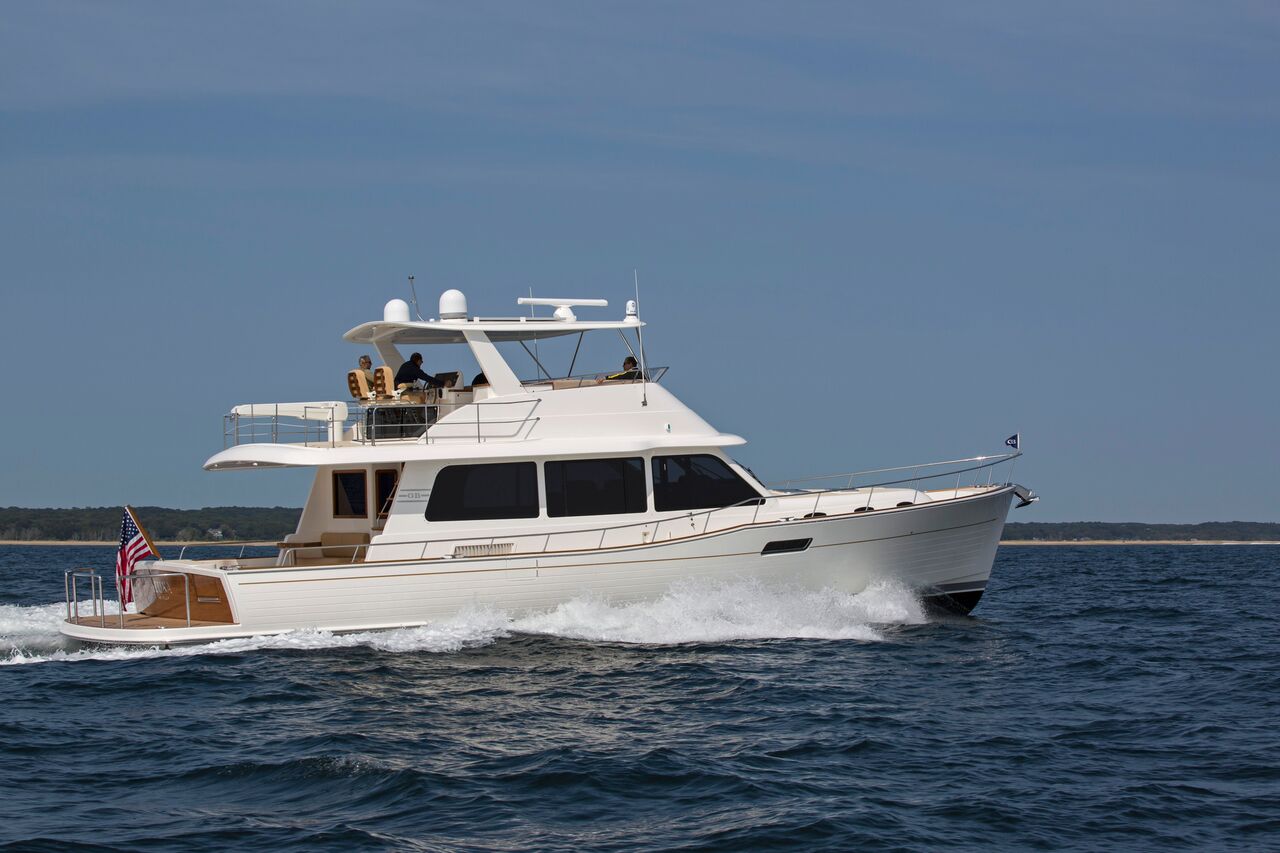This is all you need to know about the gorgeous, all-new Grand Banks 60, the flagship of the legendary builder’s fleet: As we were cruising down Long Island Sound at 24 knots a few days ago, the ride was so smooth, so quiet and so comfortable, that Sue Weisman, the owner’s wife who had just spent a busy day provisioning her new boat, went below to take a shower. She emerged 15 minutes later, smiling and happy. No fuss, no muss, no problems. A hot refreshing shower, just like home, at 24 knots. Don’t try this on many boats.
“This is a totally different kind of boat,” Mark Richards, the CEO of Grand Banks, said a few days earlier when he walked me and George Day, my Cruising Odyssey colleague, through the new 60 at the Newport boat show. “You’ve got to take a ride to believe it.” I did take a ride, and I do believe it.
The crew on board the 60 on this picture-perfect, blue-sky, late September day were hardly new to boating, and they all were more and more impressed by how the boat performed the more time they spent underway. There were six of us: Gary Weisman, the new owner, who had retired four years ago as the president of North Sails, living in San Diego. An ardent fisherman, he and Sue had owned a Bertram 38 at first and then a Riviera 47 for 15 years. “We used it a lot, fishing in Mexico,” Weisman said. In fact, they put 50,000 miles on the Riviera. But now he wanted to do some long-range cruising as well as occasional fishing, so he turned to Grand Banks.
Then there were Tom Whidden and his wife, Betsy. Whidden, one of the best sailors in the world and a long-time America’s Cup tactician, had just been inducted into the National Sailing Hall of Fame the previous day. Living in Essex, Connecticut, he is CEO of North Technology Group, which includes North Sales and EdgeWater Boats. The Whiddens have just bought a Grand Banks 60, and they expect to take delivery of it over the winter. “I’m relaxed about it,” he said. “I know I’ll have it for next spring.” The 60 will be their third Grand Banks. They just sold their Eastbay 55. “I loved my old boat,” Whidden said. “But then I found out what this new one is all about and I wanted it.” Also on board to get everyone acquainted with the systems on the new 60 was Hank Compton, a managing director of Grand Banks and Palm Beach Motor Yachts who lives in Singapore and works out of the factory in Malaysia.
We met on the boat at Norwalk Cove Marina in Connecticut, the day after the Norwalk Boat Show, where the 60, hull number three, had been the star of the Grand Banks’ display. It had been introduced to the U.S. market at the Newport show the previous week. The six of us were going to ride down the Sound and East River to North Cove Marina on the lower Hudson in the Battery district of New York City. After an overnight there, the Whiddens and the Weismans were going to take the boat to Cape May, New Jersey, and then Annapolis.
This was the first time the Weismans had been on their new boat, and as Sue was busy unloading boxes of clothing and dishes, Gary turned on the Fischer Panda 25,000i genset. “Is it on?” Whidden asked. The Fischer Panda 25,000i generator was so quiet and the Grand Banks’ soundproofing was so good that we couldn’t hear it. Weisman turned it off and then on again as we listened and finally detected a very slight sound just over the low hum of the Seakeeper gyrostabilizer that was warming up. 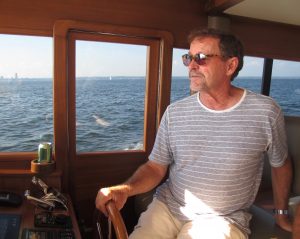
( Weisman at the helm.)
A three-stateroom, two-head, luxurious long range-cruiser designed to be run by a couple, the 60 is the result of Richards’ revamping of Grand Banks since he took over as CEO in 2014. One of the best sailors in the world, Richards has won the grueling (and occasionally deadly) Sydney-Hobart race a record eight times. An Australian, he was the founder and CEO of Palm Beach when it was acquired by Grand Banks in 2014 and he was put in charge of both companies, totally revamping the Grand Banks factory in Malaysia. Drawing on his high-tech sailing background, Richards built the 60 with state-of-the-art, light-weight materials to give the boat a low center of gravity for stability and a warped hull for performance over the entire speed range. (As I found testing the boat on Long Island Sound, this works: It topped out at 31.1 knots, but dialed back to 7.3 knots it had a range – with a 10 percent reserve – of an incredible 5,026 nm.)
To keep the boat’s weight down, the deck and flybridge are fully carbon infused; all vinylester resins and a cross-linked Corecell foam core make for a highly efficient power-to-weight ratio. Monocoque construction bonds all the bulkheads and interior furniture directly to the hull and deck for extra strength and quiet. The hull has a fine entry and almost flat, lift-producing sections aft with only 8 degrees of deadrise at the transom. “The hull is incredibly efficient,” Richards said. “Look at the wake underway; you could almost run a straightedge on it.”
Standard power comes from two 725-hp Volvo Penta diesels, but this boat has two 1,000-hp Cat 12.9 diesels paired with Twin Disc MGX transmissions with EC300 controls and Sea Torque enclosed shaft system. The bow and stern thrusters are proportional for total fingertip control while docking. The boat has a CE Category A rating for safety.
The 60’s lines are clean, flowing and contemporary. Standing on the bow in Newport, looking back, Richards said, “She’s pretty, isn’t she?” Yes, definitely, but the new boat also belongs in the classic Grand Banks family. “The Grand Banks brand is phenomenal, legendary,” Richards said. “We revived it. This still has lines of the 42, one of the most popular cruising boats ever. It has family ties.”
Time for full disclosure: I’ve been a Grand Banks fan for decades. In fact, I owned a 36 Classic for many years, cruising it from Fort Myers on the Gulf Coast of Florida to the Keys and then up the East Coast to Norwalk Cove, where I lived aboard for a few years. I loved the boat. My wife did too, although on our subsequent annual summer vacations to Nantucket she would tell her friends, “It’s stately, but it’s slow.” I have to admit that at eight knots (on a good day) it did take a while to get anywhere. And over the years, I’ve tested Grand Banks in many parts of the world – Singapore, Istanbul, the Bahamas, the San Juans – and once had a memorable voyage on a Grand Banks 49 uphill from San Francisco to Seattle.
Looking at the new 60 from the side, you can see the traditional Grand Banks’ long, sleek sheer line, gently broken amidships, accenting the length of the boat. From the bow, the hull has a lot of flair, almost a Carolina flair, unusual for a Grand Banks but designed to keep the boat dry in a head sea. And from the stern, there’s enough tumblehome to keep the Down East crowd happy.
Since Weisman wants to continue fishing, this boat had some custom features designed for him. The helm station on the flybridge was moved aft, for example, and four feet were eliminated from the boat deck overhang so he can watch the action from up there. And the usual seating in the cockpit has been rearranged a bit to free up the transom for bait wells and fishing activity.
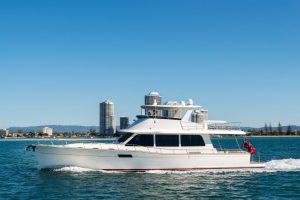
(Here’s the standard version of the Grand Banks 60, with the longer boat deck and more forward helm on the flybridge.)
Weisman’s boat’s name Iluka is announced in slightly raised gold lettering on the teak transom; the letters actually reflected off the teak swim platform in the afternoon sun. Weisman explained that he and Sue, who’s from Australia, wanted an aboriginal name for the boat, and Iluka means “near the sea” in that native tongue. Oddly enough, growing up, Sue lived on Iluka Street in Palm Beach, the same town just north of Sydney where Mark Richards founded Palm Beach Motor Yachts.
Once we got underway, the boat easily came up on plane, although in this case that phraseology really isn’t appropriate. It doesn’t “come up on plane.” With almost no bow rise, it simply moves ahead, quietly and firmly. Looking at the Garmin display, Weisman said, “I can’t believe we’re doing 18 knots.” In fact, there was almost no feeling of speed at all. As we moved up to our cruising speed of 24 knots, I looked aft to see what the wake was like. As Richards had mentioned it, it was remarkably low and undisturbed for a 60-foot boat.
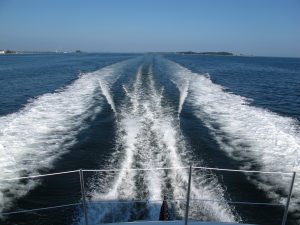
(Here’s the wake at 24 knots.)
When we were off Greenwich, I took the performance numbers, and they were impressive. There were six of us on board and the boat had 775 gallons of fuel and 75 gallons of water. The Sound was fairly flat there, sparkling in the bright afternoon sun, with very little breeze. I took sound readings at the lower helm, and figured the range based on a 10 percent reserve.
At 600 rpm, the boat went 7.3 knots, burning just 2 gph, giving it a range of 5,026 nm!
At 1500 rpm, the boat went 18 knots, burning 32 gph, with a range of 774. The decibel level here was only 69 dB(A), just above the level of normal conversation.
At 2000 rpm, the boat went 26.4 knots, burning 72 gph, for a range of 504 nm.
And at a wide-open 2310 rpm, the boat went 31.1 knots, burning 100 gph for a range of 428 nm.
All this means you can go just about anywhere you want to go in this boat. This afternoon we could have headed for Bermuda and come back without having to refuel. Instead, we were just going to New York. The two Weismans relaxed on the helm seat, while the Whiddens, often joined by Compton, when he wasn’t taking notes, were comfortable on the matching seat on the port side. Weisman drove with the teak destroyer wheel, watching the two Garmin chartplotters and twin Cat engine displays on the dash. A door to his right opened to the starboard side deck, providing easy access for docking or maneuvering through locks.
You climb on board the 60 via the large teak swim platform or through a door, about two-thirds of the way aft, on each side. From the swim platform, a sturdy inward-opening door leads to the cockpit, which has a beautiful teak table and an aft-facing seat for four on the forward port side. On the starboard side forward is a sink and bar with a fridge tucked under the steps and ladder going up to the flybridge. Under the sink is a drawer you can pull out that has controls for the engines, gears and thrusters so you can dock the boat from back here. The cockpit has a teak sole; so do the side decks going forward until they get opposite the helm, then there are two teak steps up to the foredeck, which is covered with nonskid.
A super-sized hatch opens in the middle of the cockpit for access to the lazarette and engine room. Two smaller hatches farther aft on each side also allow fast access to the lazarette for stowing lines and fenders. From the middle hatch, it’s three steps down and then a watertight door opens to the engine room forward. In our tour of the boat earlier in Newport, Richards, Day and I all fit in here easily, although everyone had to stoop (but then we’re all tall). What you give up in head room, you gain in side access to the big Cats, which is exceptional. There are several feet of working space outboard of each engine, and all the machinery and equipment is well laid-out, user-friendly, accessible and immaculate. The massive 1,530-gallon fuel tank is forward, separating the engine room from the living quarters.
From the cockpit, you enter the salon through a beautiful teak and glass sliding door. The large galley is on the port side, with a U-shaped Silestone countertop, a deep sink, three-burner Miele cooktop, dishwasher and drawers and cabinets for storage everywhere. The fridge, freezer and wine cabinet are across the way on the starboard side. You push a button and the big window separating the salon from the cockpit aft powers down all the way. Push other buttons and shelves over the sink and the forward countertop also power down, giving easy access to kitchen equipment and cooking supplies.
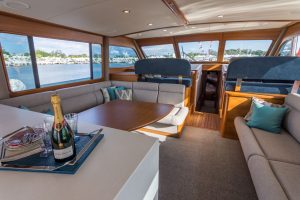
(The salon, filled with space and light.)
The salon is luxurious, filled with light, and comfortable. On the port side, an L-shaped settee could easily seat a family of six or more, and faces a bi-fold teak table on a stainless-steel pedestal and two ottomans with storage inside. On the starboard side, there’s a bench settee that could seat four or five people; behind it is the hi-low TV. Three huge windows on each side (two power down to open all the way) and three equally large forward windshields let in a lot of natural light.
Forward, you go down four teak stairs to the accommodations deck. First, on the starboard side, is the guest cabin, with one berth opposite the door; then you turn aft and go down a step and find another berth running athwartships under the helm. A washer and dryer are stacked behind the door.
Then a bit forward and to port is the master stateroom midships, with an island bed coming out from the port side. There’s lots of walking-around space, and headroom, in the master to make it feel like home. Walk aft and you take a step down to find a large closet and clothes storage area – a hanging locker and three drawers on one side and three dresser drawers on the other. Two more drawers are under each side of the bed. Forward, the master head is unusually bright with light streaming in from an overhead hatch and a side port. The shower is large with a big glass door. And there’s a heated towel rack.

(The master stateroom, with space, storage and light all around.)
Moving down the companionway, the second head is on the starboard side, and is virtually the same as the master, even down to the heated towel rack. All the way forward, the VIP stateroom has a walkaround bed, a hanging locker to port and drawers and a cabinet to starboard.
And so, on this beautiful late September afternoon we swept down Long Island Sound, passing only one or two other boats, going under the Throgs Neck and Whitestone Bridges at an easy, loafing 24-plus knots. After LaGuardia Airport, we powered through Hell Gate, where water from the Sound and the East River meet and can explode into three-feet standing waves, but it was relatively calm at this time and we just got a touch of water up on the port windshield.
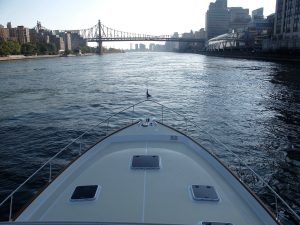
(Heading down the East River in Manhattan.)
Finally, cruising down the East River, past rush-hour cars stacked up on the FDR Drive, we passed by mid-town and the UN, then under the bridges until, at the tip of Manhattan, and just across from the Statue of Liberty, we made a right turn at the Battery. Weisman made sure to give the Staten Island Ferry lots of room, and then headed up the Hudson a bit to North Cove.
After he backed into the slip and we tied up, Weisman stood in the cockpit, happy and smiling. “Feel that?” he said. “We’re not rocking. All the other boats here are rocking. I love it.” The Whiddens agreed. Everyone was pleased with the 60’s performance. Weisman was particularly happy about the boat’s range. After the boat show season, he and Sue will take the new 60 to the Bahamas, the Caribbean and through the Panama Canal, fishing on both sides of Central America. They’ll put the Grand Banks on a freighter in Costa Rica and ship it up the west coast to Vancouver, and then cruise and fish in Alaska next summer before cruising back home to San Diego. “At least that’s the plan,” he said. “But I know we’ll have a great time on this boat.”
Specs.: LOA: 65’4”; Beam: 19’2”; Draft: 4’7”; Disp.: 63,900 lbs.; Fuel: 1,530 gals.; Water: 300 gals.; Power: (base) 2×725-hp Volvo diesels; (as tested) 2×1,000-hp Cat diesels. Base price: $3,280,000.
